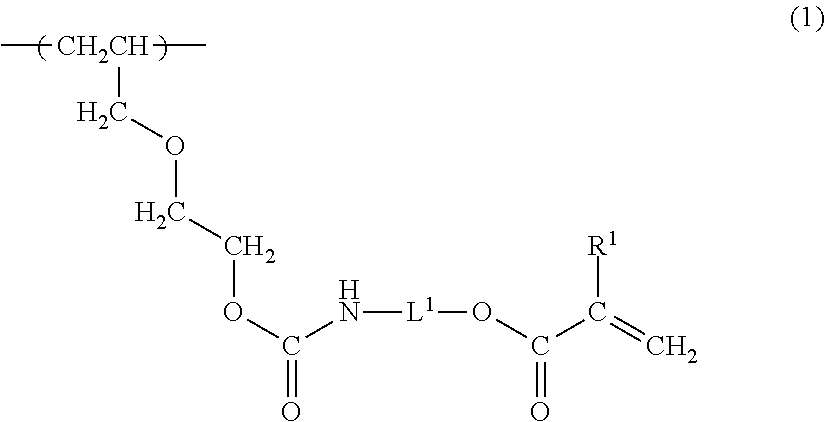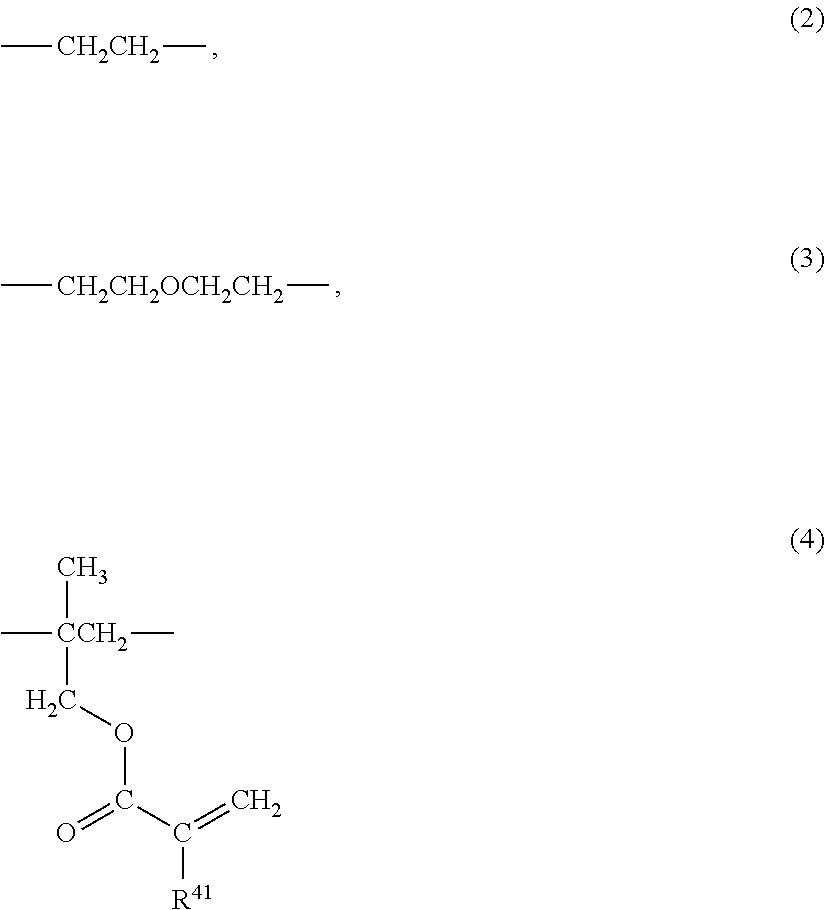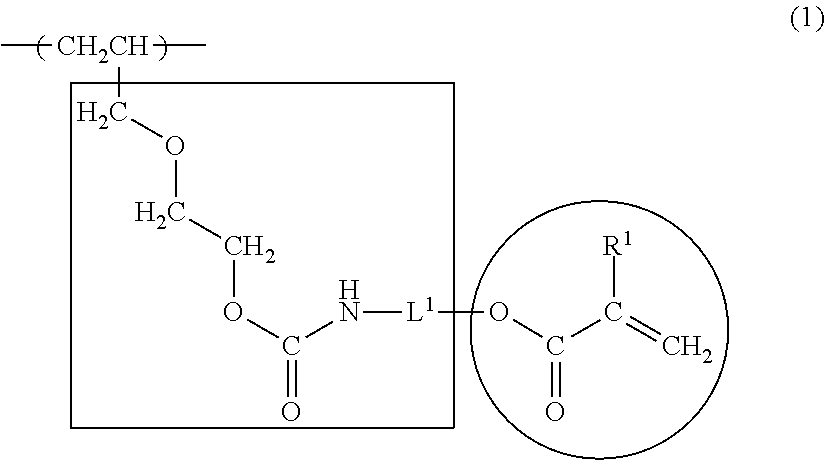Radiation-curable vinyl chloride copolymer, radiation-curable composition, and magnetic recording medium
a technology of vinyl chloride copolymer and composition, which is applied in the manufacture of flux-sensitive heads, instruments, record information storage, etc., can solve the problems of difficult formation of crosslinked structures, and achieve good curability
- Summary
- Abstract
- Description
- Claims
- Application Information
AI Technical Summary
Benefits of technology
Problems solved by technology
Method used
Image
Examples
example 1
(1) Polymerization of the Vinyl Chloride Copolymer
Vinyl chloride: 100 parts
Allyl glycidyl ether: 11.9 parts
2-Hydroxypropyl methacrylate: 4.1 parts
Allyl-2-hydroxyethyl ether: 3.6 parts
Sodium lauryl sulfate: 0.8 part
Water: 117 parts
were charged and the mixture was stirred at 50° C.
Subsequently,
Potassium persulfate: 0.6 part
[0216]was charged and emulsion polymerization was begun. After reacting for 10 hours, cooling was conducted when the pressure in the polymerization vessel reached 2 kg / cm2. The unreacted vinyl chloride was recovered and the product was drained, washed, and dried, yielding vinyl chloride copolymer (1) with a copolymerization ratio (mol percent) of:
Vinyl chloride: 93.0 mole percent
Allyl glycidyl ether: 4.0 mole percent
2-Hydroxypropyl methacrylate: 1.0 mole percent
Allyl-2-hydroxyethyl ether: 1.0 mole percent
Units in which the epoxy group of the allyl glycidyl ether had been opened by sulfuric acid: 1.0 mole percent
(2) Radiation-Curable Functional Group-Introducing Reac...
example 2
[0222]With the exception that 2-(2-isocyanate ethyloxy)ethyl methacrylate (Karenz_MOI-EG made by Showa Denki K.K.) was employed instead of 2-methacryloyloxyethyl isocyanate in the radiation-curable functional group-introducing reaction of Example 1, a resin solution of radiation-curable functional group-containing vinyl chloride copolymer (Example Compound (2)) was obtained by the same method as in Example 1. The 1H NMR data and its assignments of the radiation-curable functional group-containing vinyl chloride copolymer obtained are given below.
[0223]1H-NMR (DMSO-d6) δ(ppm)=6.2-6.0 (peak of C═C double bond), 5.8-5.6 (peak of C═C double bond), 4.6-4.2 (br., m), 4.2-4.0 (br., m), 3.9-3.1 (br., m), 3.1-3.0 (br., s), 2.7-2.65 (br., s), 2.60-2.0 (m), 2.0-0.7 (br., m).
[0224]The average molecular weight, Tg, sulfate group concentration, and radiation-curable functional group concentration were measured in the same manner as in Example 1. The results are given in Table 1.
example 3
[0225]With the exception that 2-acryloyloxyethyl isocyanate (Karenz_AOI made by Showa Denki K.K.) was employed instead of 2-methacryloyloxyethyl isocyanate in the radiation-curable functional group-introducing reaction of Example 1, a resin solution of radiation-curable functional group-containing vinyl chloride copolymer (Example Compound (3)) was obtained by the same method as in Example 1. The 1H NMR data and its assignments of the radiation-curable functional group-containing vinyl chloride copolymer obtained are given below.
[0226]1H-NMR (DMSO-d6) δ(ppm)=6.2-6.0 (peak of C═C double bond), 5.8-5.6 (peak of C═C double bond), 4.6-4.2 (br., m), 4.2-4.0 (br., m), 3.9-3.1 (m), 3.1-3.0 (br., s), 2.7-2.65 (br., s), 2.60-2.0 (m), 2.0-0.7 (br., m).
[0227]The average molecular weight, Tg, sulfate group concentration, and radiation-curable functional group concentration were measured in the same manner as in Example 1. The results are given in Table 1.
PUM
| Property | Measurement | Unit |
|---|---|---|
| glass transition temperature | aaaaa | aaaaa |
| glass transition temperature | aaaaa | aaaaa |
| glass transition temperature | aaaaa | aaaaa |
Abstract
Description
Claims
Application Information
 Login to View More
Login to View More - R&D
- Intellectual Property
- Life Sciences
- Materials
- Tech Scout
- Unparalleled Data Quality
- Higher Quality Content
- 60% Fewer Hallucinations
Browse by: Latest US Patents, China's latest patents, Technical Efficacy Thesaurus, Application Domain, Technology Topic, Popular Technical Reports.
© 2025 PatSnap. All rights reserved.Legal|Privacy policy|Modern Slavery Act Transparency Statement|Sitemap|About US| Contact US: help@patsnap.com



